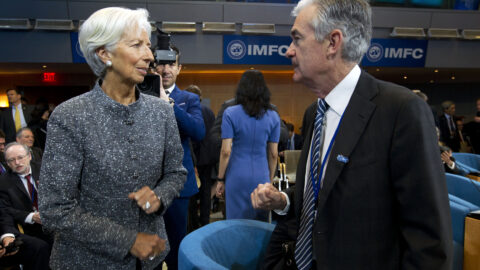From a technical point of view, the concept of a “year-end rally” is a myth. At least, this is what empirical evidence is telling us. In the past 10 years, the S&P 500, for example, posted a December performance, on average, of 1.12%, making December only the 5th-best month of the year (Fig.1). Over the entire period – from 2006 to 2015 – there was not a single year, in which December was the best performing month.
For the Stoxx Europe 600, the picture is similar. The average December performance from 2006 to 2015 was 0.77%, making December the 5th best month of the year in Europe as well. Only once during the past decade, in 2006, the December performance was higher than in any other month of the year.
The fact that the empirical evidence does not support the notion of a “year-end rally” is no big surprise. That a year ends on the 31st of December according to the Gregorian calendar is one of the best-known facts in the world. If there was a better-than-random chance to profit from this event, financial markets would be grossly inefficient – which they are clearly not.
Near-term support for stocks
While there is clearly no pattern of regularly soaring markets towards year-end, the question what factors will drive equity markets in the near-term is fully understandable and legitimate. There are several positive developments that will likely support stocks in the next weeks:
- The ‘reflation trade’ – the bet that equity market will receive support from expansionary economic policies and a pick-up in inflation – is gaining momentum. This theme started evolving during summer but has gained traction as a result of the outcome of US election. While many details are still unknown about the next president’s economic program, the announced infrastructure program and tax cuts are estimated to add about 1% to US economic growth in 2017 and 2018. This and the intended protectionist measures will likely strengthen inflationary pressures.
- In addition to the improving economic outlook for 2017, also the current economic news flow is getting better across the developed world. Recently, the Citi Economic Surprise Indicators have moved into positive territory in the US, Europe and Japan.
- Corporate earnings could turn out to be another source of tailwinds for stocks. After a series of disappointing reporting seasons, third quarter interims both in the US and in Europe surprised on the upside and signaled that the earnings recession is coming to an end.
- Investors’ more constructive view on equities is also underpinned by sharply rising inflows into equity funds. According to Bank of America’s recent fund flow monitor (“Violent Rotation”, dated Nov 17), the week before saw the “largest equity inflows in 2 years ($28bn)” and the “biggest bond redemptions in 3½ years”.
Looming event risks
While improving fundamentals suggest that the overall market backdrop has turned more equity friendly, there are reasons to remain cautious, particularly in face of significant event risks both in Europe and in the US:
- In Europe, the Italian referendum on December 4 could have a market moving impact. It will likely both increase political uncertainty in Italy, and more importantly, fuel speculation of another Euro crisis in 2017. That said, the Brexit-example demonstrated that markets do not seem to be overly concerned about the longer-term implications of political events on the future of the “European project”. Italy will continue to struggle on, and the possible fallout on the future of the common currency will not be immediately noticeable.
- On December 14, the Federal Reserve Bank will most likely lift the interest rate by another 25 basis points. This has more or less been flagged by the Chairwoman Yellen and this is also what markets expect. The implied probability of a rate hike by the future market has climbed to 100%. Therefore, markets will not be surprised by the hike itself, particularly, when it comes together with strong activity data in the next 2-3 weeks. However, the Fed’s guidance for next year may still surprise investors (too dovish or too hawkish, who knows), pushing up volatility.
- Finally, while the broad direction of Donald Trump’s economic agenda is known, there are still many black holes regarding its details and timing and on personnel. US politics will have the potential to surprise investors for some time.
Markets have already strongly responded to the new post-election pre-Trump environment. The main US equity indices have reached all-time highs, the US dollar is trading at 15 year highs and US treasury yields jumped almost 60 basis points relative to pre-election levels (Fig.2). The fact that implied equity volatility quickly has returned to pre-election levels – falling below 13 in the US and touching 20 in Europe – suggests that investors try to believe in the reflation scenario and are not overly concerned about the event-risks listed above.
Regional differences
In light of recent trends and foreseeable event risks, the near-term outlook differs for various regions:
- While US stocks have benefited the most from the post-election rally (Fig.3), the positive momentum could continue until the end of the year. The recent rise in bond yields and the anticipated easing of financial regulation support US financials (approximately 15% of the market’s total capitalization) the most. Moreover, US-companies will be the main beneficiaries from the anticipated increase of infrastructure spending and possibly also from tax-reform, although it will take months before the specifics of the new government’s fiscal expansion will be known. Overall, risks for the US until year-end are skewed to the upside.
- In Europe, key drivers will be the outcomes of a number of events in December. In addition to the Italian referendum mentioned above, the ECB meeting on December 8 will signal how committed the Central Bank still is to its “whatever it takes” position. And the presidential election in Austria, while not overly important in itself, may be seen as an indicator, how right-wing populism will perform in next year’s elections in the Netherlands, France and Germany. Overall, risks in Europe seem skewed to the downside.
- Emerging Markets (EM) have suffered after the election (Fig.3) and will likely stay under pressure longer term reflecting dollar strength and higher US bond yields as well as the threat of a more protectionist trade regime. That said, if Fed-chair Janet Yellen manages to combine a moderate rate hike with a dovish guidance for 2017, there is a chance of EM equities and currencies bouncing back after their post-Trump correction.
However, as interesting as it may be to speculate about the likelihood of a year-end rally or about the reasons, why we not get one, the more important issue is to comprehend how the world has changed during the past, say, 12 months. This will be the real challenge in 2017 and probably beyond.
Legal disclaimer
This document is an advertisement. Unless indicated otherwise, source: Erste Asset Management GmbH. The language of communication of the sales offices is German and the languages of communication of the Management Company also include English.
The prospectus for UCITS funds (including any amendments) is prepared and published in accordance with the provisions of the InvFG 2011 as amended. Information for Investors pursuant to § 21 AIFMG is prepared for the alternative investment funds (AIF) administered by Erste Asset Management GmbH pursuant to the provisions of the AIFMG in conjunction with the InvFG 2011.
The currently valid versions of the prospectus, the Information for Investors pursuant to § 21 AIFMG, and the key information document can be found on the website www.erste-am.com under “Mandatory publications” and can be obtained free of charge by interested investors at the offices of the Management Company and at the offices of the depositary bank. The exact date of the most recent publication of the prospectus, the languages in which the fund prospectus or the Information for Investors pursuant to Art 21 AIFMG and the key information document are available, and any other locations where the documents can be obtained are indicated on the website www.erste-am.com. A summary of the investor rights is available in German and English on the website www.erste-am.com/investor-rights and can also be obtained from the Management Company.
The Management Company can decide to suspend the provisions it has taken for the sale of unit certificates in other countries in accordance with the regulatory requirements.
Note: You are about to purchase a product that may be difficult to understand. We recommend that you read the indicated fund documents before making an investment decision. In addition to the locations listed above, you can obtain these documents free of charge at the offices of the referring Sparkassen bank and the offices of Erste Bank der oesterreichischen Sparkassen AG. You can also access these documents electronically at www.erste-am.com.
Our analyses and conclusions are general in nature and do not take into account the individual characteristics of our investors in terms of earnings, taxation, experience and knowledge, investment objective, financial position, capacity for loss, and risk tolerance. Past performance is not a reliable indicator of the future performance of a fund.
Please note: Investments in securities entail risks in addition to the opportunities presented here. The value of units and their earnings can rise and fall. Changes in exchange rates can also have a positive or negative effect on the value of an investment. For this reason, you may receive less than your originally invested amount when you redeem your units. Persons who are interested in purchasing units in investment funds are advised to read the current fund prospectus(es) and the Information for Investors pursuant to § 21 AIFMG, especially the risk notices they contain, before making an investment decision. If the fund currency is different than the investor’s home currency, changes in the relevant exchange rate can positively or negatively influence the value of the investment and the amount of the costs associated with the fund in the home currency.
We are not permitted to directly or indirectly offer, sell, transfer, or deliver this financial product to natural or legal persons whose place of residence or domicile is located in a country where this is legally prohibited. In this case, we may not provide any product information, either.
Please consult the corresponding information in the fund prospectus and the Information for Investors pursuant to § 21 AIFMG for restrictions on the sale of the fund to American or Russian citizens.
It is expressly noted that this communication does not provide any investment recommendations, but only expresses our current market assessment. Thus, this communication is not a substitute for investment advice.
This document does not represent a sales activity of the Management Company and therefore may not be construed as an offer for the purchase or sale of financial or investment instruments.
Erste Asset Management GmbH is affiliated with the Erste Bank and austrian Sparkassen banks.
Please also read the “Information about us and our securities services” published by your bank.






